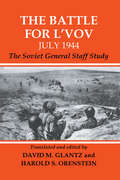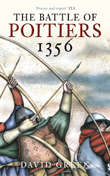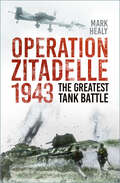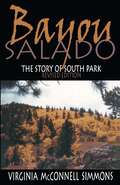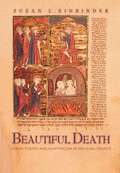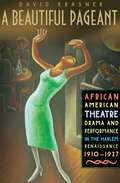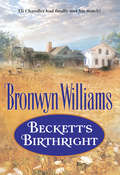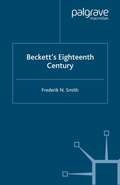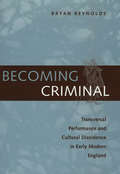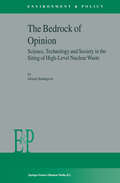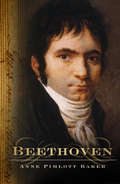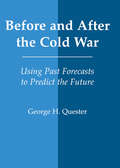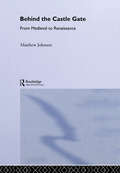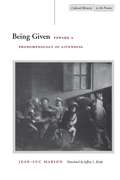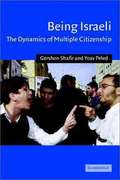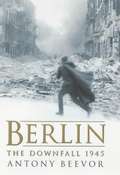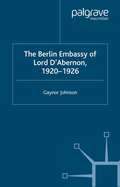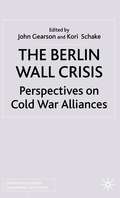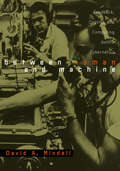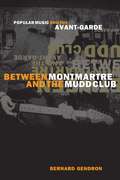- Table View
- List View
The Battle for L'vov July 1944: The Soviet General Staff Study (Soviet (Russian) Study of War)
by David Glantz Harold S. OrensteinThe Red Army's summer offensive of 1944 against Hitler's Wehrmacht was unprecedented in terms of its scale, scope, and strategic intent and impact. This study details how the Red Army accomplished this feat in the words of those individuals who planned and orchestrated the offensive.
The Battle for L'vov July 1944: The Soviet General Staff Study (Soviet (Russian) Study of War #No. 13)
by David M. Glantz Harold S. OrensteinThe Red Army's summer offensive of 1944 against Hitler's Wehrmacht was unprecedented in terms of its scale, scope, and strategic intent and impact. This study details how the Red Army accomplished this feat in the words of those individuals who planned and orchestrated the offensive.
The Battle of Poitiers 1356
by David GreenThe victory at Poitiers by an English force outnumbered two-to-one, led by Edward the Black Prince on 19th September 1356 was one of the most significant of the Hundred Years War. The consequences of the battle resonated throughout the remainder of the century and influenced the war to its end in 1453. David Green has researched the battle and the raids that preceded it exhaustively and details the strategy, tactics, arms and armour used by both sides. He reconstructs the battle using an array of contemporary sources and discusses the protagonists, the siting, course and outcome of the encounter and considers the implications of the capture of King Jean II of France and many of the most important members of the French nobility.
Battle Story: The Greatest Tank Battle In History (Armour In Theatre Ser. #No. 16)
by Mark HealyIn July 1943, Hitler launched Operation Zitadelle, the last German offensive on the Eastern Front. It was an attempt to shorten the German lines by eliminating the Kursk salient – created after their defeat at Stalingrad – and was designed to result in the encirclement of the Red Army. In reality the German tanks came up against impenetrable Russian defences: minefields, artillery and anti-tank emplacements, spread through lines 250km deep and manned by Russian troops whose actions often verged on the suicidal. The greatest tank battle in history, Kursk assured the Nazis’ defeat and was ‘the swan song of the German tank arm’. Involving over 9000 tanks, 5000 aircraft, 35,000 guns and mortars and 2,700,000 troops (of whom 230,000 became casualties), the Battle of Kursk was a conflict whose scale and barbarity eclipsed all other clashes in Europe. This book gives a clear, concise account of those dramatic days in 1943, supported by a timeline of events and orders of battle, and illustrated with over fifty photographs.
Bayou Salado: The Story of South Park, Revised Edition
by Virginia McConnell SimmonsFirst published in 1966, Bayou Salado is an engaging look at the history of a high cool valley in the Rocky Mountains. Now known as South Park, Bayou Salado once attracted Ute and Arapaho hunters as well as European and American explorers and trappers. Virginia McConnell Simmons's colorful accounts of some of the valley's more notable residents - such as Father Dyer, the skiing Methodist minister-mailman, and Silver Heels, the dancer who lost her legendary beauty while tending to the ill during a small pox epidemic - bring the valley's storied past to life.
Beautiful Death: Jewish Poetry and Martyrdom in Medieval France
by Susan L. EinbinderWhen Crusader armies on their way to the Holy Land attacked Jewish communities in the Rhine Valley, many Jews chose suicide over death at the hands of Christian mobs. With their defiant deaths, the medieval Jewish martyr was born. With the literary commemoration of the victims, Jewish martyrology followed. Beautiful Death examines the evolution of a long-neglected corpus of Hebrew poetry, the laments reflecting the specific conditions of Jewish life in northern France. The poems offer insight into everyday life and into the ways medieval French Jews responded to persecution. They also suggest that poetry was used to encourage resistance to intensifying pressures to convert. The educated Jewish elite in northern France was highly acculturated. Their poetry--particularly that emerging from the innovative Tosafist schools--reflects their engagement with the vernacular renaissance unfolding around them, as well as conscious and unconscious absorption of Christian popular beliefs and hagiographical conventions. At the same time, their extraordinary poems signal an increasingly harsh repudiation of Christianity's sacred symbols and beliefs. They reveal a complex relationship to Christian culture as Jews internalized elements of medieval culture even while expressing a powerful revulsion against the forms and beliefs of Christian life. This gracefully written study crosses traditional boundaries of history and literature and of Jewish and general medieval scholarship. Focusing on specific incidents of persecution and the literary commemorations they produced, it offers unique insights into the historical conditions in which these poems were written and performed.
Beautiful Death: Jewish Poetry and Martyrdom in Medieval France (PDF)
by Susan L. EinbinderWhen Crusader armies on their way to the Holy Land attacked Jewish communities in the Rhine Valley, many Jews chose suicide over death at the hands of Christian mobs. With their defiant deaths, the medieval Jewish martyr was born. With the literary commemoration of the victims, Jewish martyrology followed. Beautiful Death examines the evolution of a long-neglected corpus of Hebrew poetry, the laments reflecting the specific conditions of Jewish life in northern France. The poems offer insight into everyday life and into the ways medieval French Jews responded to persecution. They also suggest that poetry was used to encourage resistance to intensifying pressures to convert. The educated Jewish elite in northern France was highly acculturated. Their poetry--particularly that emerging from the innovative Tosafist schools--reflects their engagement with the vernacular renaissance unfolding around them, as well as conscious and unconscious absorption of Christian popular beliefs and hagiographical conventions. At the same time, their extraordinary poems signal an increasingly harsh repudiation of Christianity's sacred symbols and beliefs. They reveal a complex relationship to Christian culture as Jews internalized elements of medieval culture even while expressing a powerful revulsion against the forms and beliefs of Christian life. This gracefully written study crosses traditional boundaries of history and literature and of Jewish and general medieval scholarship. Focusing on specific incidents of persecution and the literary commemorations they produced, it offers unique insights into the historical conditions in which these poems were written and performed.
A Beautiful Pageant: African American Theatre, Drama and Performance in the Harlem Renaissance
by D. KrasnerThe Harlem Renaissance was an unprecedented period of vitality in the American Arts. Defined as the years between 1910 and 1927, it was the time when Harlem came alive with theater, drama, sports, dance and politics. Looking at events as diverse as the prizefight between Jack Johnson and Jim 'White Hope' Jeffries, the choreography of Aida Walker and Ethel Waters, the writing of Zora Neale Hurston and the musicals of the period, Krasner paints a vibrant portrait of those years. This was the time when the residents of northern Manhattan were leading their downtown counterparts at the vanguard of artistic ferment while at the same time playing a pivotal role in the evolution of Black nationalism. This is a thrilling piece of work by an author who has been working towards this major opus for years now. It will become a classic that will stay on the American history and theater shelves for years to come.
Beckett's Birthright (Mills And Boon Historical Ser.)
by Bronwyn WilliamsEli Chandler didn't need a redheaded wildcat to complicate his life. What with a fiancée gone missing and a wily gambler on the loose, the ranch manager had enough on his plate. So why did he hunger after the boss's daughter, with a newly whetted appetite for love?
Beckett's Eighteenth Century
by F. SmithBeckett's Eighteenth Century is the first book-length study of Samuel Beckett's affinity with the British eighteenth century and of the influence of its writers on his work. Reading Swift, Pope, Defoe, Fielding, Sterne, Johnson, Gray, and other writers of this period, this study demonstrates how he was not only influenced by them but interprets them for us in a quite modern way. Beckett's uniqueness is not questioned here, but this uniqueness is shown, paradoxically, to have its roots at least in part in his native literature of two centuries ago.
Becoming Criminal: Transversal Performance and Cultural Dissidence in Early Modern England
by Bryan ReynoldsIn this book Bryan Reynolds argues that early modern England experienced a sociocultural phenomenon, unprecedented in English history, which has been largely overlooked by historians and critics. Beginning in the 1520s, a distinct "criminal culture" of beggars, vagabonds, confidence tricksters, prostitutes, and gypsies emerged and flourished. This community defined itself through its criminal conduct and dissident thought and was, in turn,officially defined by and against the dominant conceptions of English cultural normality.Examining plays, popular pamphlets, laws, poems, and scholarly work from the period, Reynolds demonstrates that this criminal culture, though diverse, was united by its own ideology, language, and aesthetic. Using his transversal theory, he shows how the enduring presence of this criminal culture markedly influenced the mainstream culture's aesthetic sensibilities, socioeconomic organization, and systems of belief. He maps the effects of the public theater's transformative force of transversality, such as through the criminality represented by Shakespeare, Jonson, Middleton, and Dekker, on both Elizabethan and Jacobean society and the scholarship devoted to it.
The Bedrock of Opinion: Science, Technology and Society in the Siting of High-Level Nuclear Waste (Environment & Policy #32)
by G. SundqvistWhen did man discover nuclear waste? To answer this question, we first have to ask if nuclear waste really is something that could be called a scientific discovery, such as might deserve a Nobel Prize in physics. In early writings within nuclear energy research radioactive waste appears to be a neglected issue, a story never told. Nuclear waste first seems to appear when a public debate arose about public health risks of nuclear power in the late 1960s and early 70s. In nuclear physics, consensus was established at an early stage about the understanding of the splitting of uranium nuclei. The fission products were identified and their chains of disintegration and radioactivity soon were well established facts among the involved scientists, as was an awareness of the risks, for example the strong radioactivity of strontium and iodine, and the poisonous effects of plutonium. However, the by-products were never, either in part or in total, called or perceived as waste, just as fission by-products. How and where to dispose of the by-products were questions that were never asked by the pioneers of nuclear physics.
Beethoven: Simplified Characters
by Anne Pimlott BakerConsidered by many the world's greatest composer, Ludwig van Beethoven achieved his ambitions against the difficulties of a bullying and drunken father, growing deafness and mounting ill-health. This biography tells the story of his life and work from his birth in Bonn in 1770 and his early employment as a court musician to his death in Vienna in 1827. It describes his studies with Haydn in Vienna and his work during the French Revolution and the rise of Napoleon. His most financially successful period followed the Congress of Vienna in 1815, despite several unhappy love affairs and continuous worry over his nephew, Karl.
Before and After the Cold War: Using Past Forecasts to Predict the Future
by George H. QuesterThe end of the Cold War came as good news for most of the world. No one had predicted the collapse of Communist rule for several decades. This book looks at how political scientists failed to predict such a quick resolution and ways in which the world might develop post Cold War.
Before and After the Cold War: Using Past Forecasts to Predict the Future
by George H. QuesterThe end of the Cold War came as good news for most of the world. No one had predicted the collapse of Communist rule for several decades. This book looks at how political scientists failed to predict such a quick resolution and ways in which the world might develop post Cold War.
Behind the Castle Gate: From the Middle Ages to the Renaissance
by Matthew JohnsonIn this engaging book Matthew Johnson looks 'behind the castle gate' to discover the truth about castles in England at the end of the Middle Ages. Traditional studies have seen castles as compromises between the needs of comfort and of defence, and as statements of wealth or power or both. By encouraging the reader to view castles in relation to their inhabitants, Matthew Johnson uncovers a whole new vantage point. He shows how castles functioned as stage-settings against which people played out roles of lord and servant, husband and wife, father and son. Building, rebuilding and living in a castle was as complex an experience as a piece of medieval art. Behind the Castle Gate brings castles and their inhabitants alive. Combining ground-breaking scholarship with fascinating narratives it will be read avidly by all with an interest in castles.
Behind the Castle Gate: From the Middle Ages to the Renaissance
by Matthew JohnsonIn this engaging book Matthew Johnson looks 'behind the castle gate' to discover the truth about castles in England at the end of the Middle Ages. Traditional studies have seen castles as compromises between the needs of comfort and of defence, and as statements of wealth or power or both. By encouraging the reader to view castles in relation to their inhabitants, Matthew Johnson uncovers a whole new vantage point. He shows how castles functioned as stage-settings against which people played out roles of lord and servant, husband and wife, father and son. Building, rebuilding and living in a castle was as complex an experience as a piece of medieval art. Behind the Castle Gate brings castles and their inhabitants alive. Combining ground-breaking scholarship with fascinating narratives it will be read avidly by all with an interest in castles.
Being Given: Toward a Phenomenology of Givenness (Cultural Memory in the Present)
by Jean-Luc MarionAlong with Husserl's Ideas and Heidegger's Being and Time, Being Given is one of the classic works of phenomenology in the twentieth century. Through readings of Kant, Husserl, Heidegger, Derrida, and twentieth-century French phenomenology (e.g., Merleau-Ponty, Levinas, and Henry), it ventures a bold and decisive reappraisal of phenomenology and its possibilities. Its author's most original work to date, the book pushes phenomenology to its limits in an attempt to redefine and recover the phenomenological ideal, which the author argues has never been realized in any of the historical phenomenologies. Against Husserl's reduction to consciousness and Heidegger's reduction to Dasein, the author proposes a third reduction to givenness, wherein phenomena appear unconditionally and show themselves from themselves at their own initiative. Being Given is the clearest, most systematic response to questions that have occupied its author for the better part of two decades. The book articulates a powerful set of concepts that should provoke new research in philosophy, religion, and art, as well as at the intersection of these disciplines. Some of the significant issues it treats include the phenomenological definition of the phenomenon, the redefinition of the gift in terms not of economy but of givenness, the nature of saturated phenomena, and the question "Who comes after the subject?" Throughout his consideration of these issues, the author carefully notes their significance for the increasingly popular fields of religious studies and philosophy of religion. Being Given is therefore indispensable reading for anyone interested in the question of the relation between the phenomenological and the theological in Marion and emergent French phenomenology.
Being Israeli: The Dynamics Of Multiple Citizenship (Cambridge Middle East Studies #Series Number 16)
by Gershon Shafir Yoav Peled Julia A. Clancy-Smith Israel Gershoni Roger Owen Yezid Sayigh Charles Tripp Judith E. TuckerA timely study by two well-known scholars offers a theoretically informed account of the political sociology of Israel. The analysis is set within its historical context as the authors trace Israel's development from Zionist settlement in the 1880s, through the establishment of the state in 1948, to the present day. Against this background the authors speculate on the relationship between identity and citizenship in Israeli society, and consider the differential rights, duties and privileges that are accorded different social strata. In this way they demonstrate that, despite ongoing tensions, the pressure of globalization and economic liberalization has gradually transformed Israel from a frontier society to one more oriented towards peace and private profit. This unexpected conclusion offers some encouragement for the future of this troubled region. However, Israel's position towards the peace process is still subject to a tug-of-war between two conceptions of citizenship: liberal citizenship on the one hand, and a combination of the remnants of republican citizenship associated with the colonial settlement with an ever more religiously defined ethno-nationalist citizenship, on the other.
Berlin: The Downfall 1945
by Antony BeevorThe advance on Berlin - which was to be the largest battle in history - began at exactly 4am on 16 April, 1945. Along the Oder Neisse front, two and a half million Soviet troops attacked one million Germans. The panic induced in the German civilian population is easy to imagine. Hitler had sworn that Germany would never be invaded, yet now overwhelming Soviet armies were advancing on Berlin. The utterly deranged Hitler ensconced deep in his concrete bunker, could only scream at his military staff. Denouncing the cowardice of the Wehrmacht, he had become convinced that Germany's defeat proved that its people were not worthy of him - that they deserved to die.
The Berlin Embassy of Lord D'Abernon, 1920-1926 (Studies in Diplomacy and International Relations)
by G. JohnsonLord D'Abernon was the first British ambassador to Berlin after the First World War. This study, which challenges his positive historical reputation, assesses all the key aspects of Anglo-German relations in the early 1920s. Particular attention is paid to the reparations question and to issues of international security. Other topics include D'Abernon's relationship with the principal British and German politicians of the period and his attitude towards American involvement in European diplomacy.
The Berlin Wall Crisis: Perspectives on Cold War Alliances (Cold War History)
by Kori SchakeThis volume highlights the complex intra-alliance politics of what was seen as the likeliest flash point of conflict in the Cold War and demonstrates how strongly determinant were concerns about relationships with allies in the choices made by all the major governments. It recounts the evolution of policy during the 1958 and 1961 Berlin crises from the perspective of each government central to the crisis, one on the margins and the military headquarters responsible for crafting an agreed Western military campaign
Between Human and Machine: Feedback, Control, and Computing before Cybernetics (Johns Hopkins Studies in the History of Technology)
by David A. MindellToday, we associate the relationship between feedback, control, and computing with Norbert Wiener's 1948 formulation of cybernetics. But the theoretical and practical foundations for cybernetics, control engineering, and digital computing were laid earlier, between the two world wars. In Between Human and Machine: Feedback, Control, and Computing before Cybernetics, David A. Mindell shows how the modern sciences of systems emerged from disparate engineering cultures and their convergence during World War II. Mindell examines four different arenas of control systems research in the United States between the world wars: naval fire control, the Sperry Gyroscope Company, the Bell Telephone Laboratories, and Vannevar Bush's laboratory at MIT. Each of these institutional sites had unique technical problems, organizational imperatives, and working environments, and each fostered a distinct engineering culture. Each also developed technologies to represent the world in a machine.At the beginning of World War II, President Roosevelt established the National Defense Research Committee, one division of which was devoted to control systems. Mindell shows how the NDRC brought together representatives from the four pre-war engineering cultures, and how its projects synthesized conceptions of control, communications, and computing. By the time Wiener articulated his vision, these ideas were already suffusing through engineering. They would profoundly influence the digital world. As a new way to conceptualize the history of computing, this book will be of great interest to historians of science, technology, and culture, as well as computer scientists and theorists. Between Human and Machine: Feedback, Control, and Computing before Cybernetics
Between Montmartre and the Mudd Club: Popular Music and the Avant-Garde
by Bernard GendronDuring the late nineteenth and early twentieth century, popular music was considered nothing but vulgar entertainment. Today, jazz and rock music are seen as forms of art, and their practitioners are regularly accorded a status on par with the cultural and political elite. To take just one recent example, Bono, lead singer and lyricist of the rock band U2, got equal and sometimes higher billing than Pope John Paul II on their shared efforts in the Jubilee 2000 debt-relief project. When and how did popular music earn so much cultural capital? To find out, Bernard Gendron investigates five key historical moments when popular music and avant-garde art transgressed the rigid boundaries separating high and low culture to form friendly alliances. He begins at the end of the nineteenth century in Paris's Montmartre district, where cabarets showcased popular music alongside poetry readings in spaces decorated with modernist art works. Two decades later, Parisian poets and musicians "slumming" in jazz clubs assimilated jazz's aesthetics in their performances and compositions. In the bebop revolution in mid-1940s America, jazz returned the compliment by absorbing modernist devices and postures, in effect transforming itself into an avant-garde art form. Mid-1960s rock music, under the leadership of the Beatles, went from being reviled as vulgar music to being acclaimed as a cutting-edge art form. Finally, Gendron takes us to the Mudd Club in the late 1970s, where New York punk and new wave rockers were setting the aesthetic agenda for a new generation of artists. Between Montmartre and the Mudd Club should be on the shelves of anyone interested in the intersections between high and low culture, art and music, or history and aesthetics.
Between Montmartre and the Mudd Club: Popular Music and the Avant-Garde
by Bernard GendronDuring the late nineteenth and early twentieth century, popular music was considered nothing but vulgar entertainment. Today, jazz and rock music are seen as forms of art, and their practitioners are regularly accorded a status on par with the cultural and political elite. To take just one recent example, Bono, lead singer and lyricist of the rock band U2, got equal and sometimes higher billing than Pope John Paul II on their shared efforts in the Jubilee 2000 debt-relief project. When and how did popular music earn so much cultural capital? To find out, Bernard Gendron investigates five key historical moments when popular music and avant-garde art transgressed the rigid boundaries separating high and low culture to form friendly alliances. He begins at the end of the nineteenth century in Paris's Montmartre district, where cabarets showcased popular music alongside poetry readings in spaces decorated with modernist art works. Two decades later, Parisian poets and musicians "slumming" in jazz clubs assimilated jazz's aesthetics in their performances and compositions. In the bebop revolution in mid-1940s America, jazz returned the compliment by absorbing modernist devices and postures, in effect transforming itself into an avant-garde art form. Mid-1960s rock music, under the leadership of the Beatles, went from being reviled as vulgar music to being acclaimed as a cutting-edge art form. Finally, Gendron takes us to the Mudd Club in the late 1970s, where New York punk and new wave rockers were setting the aesthetic agenda for a new generation of artists. Between Montmartre and the Mudd Club should be on the shelves of anyone interested in the intersections between high and low culture, art and music, or history and aesthetics.
